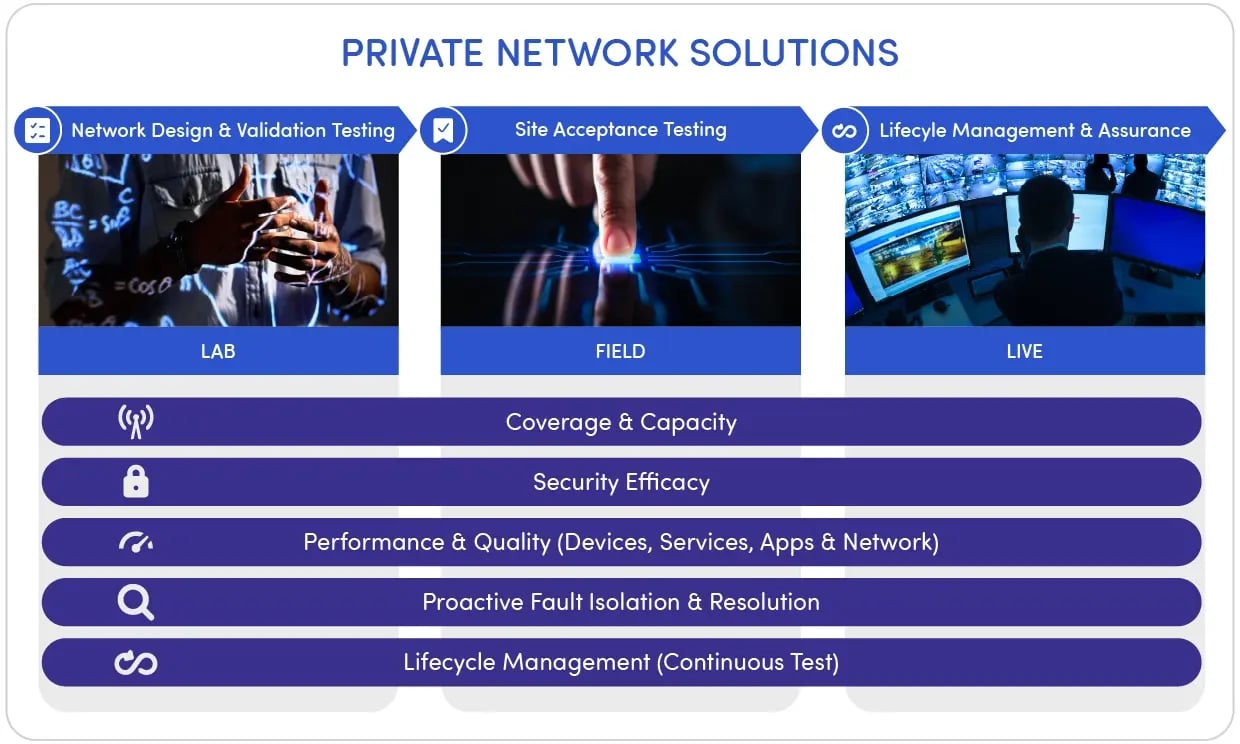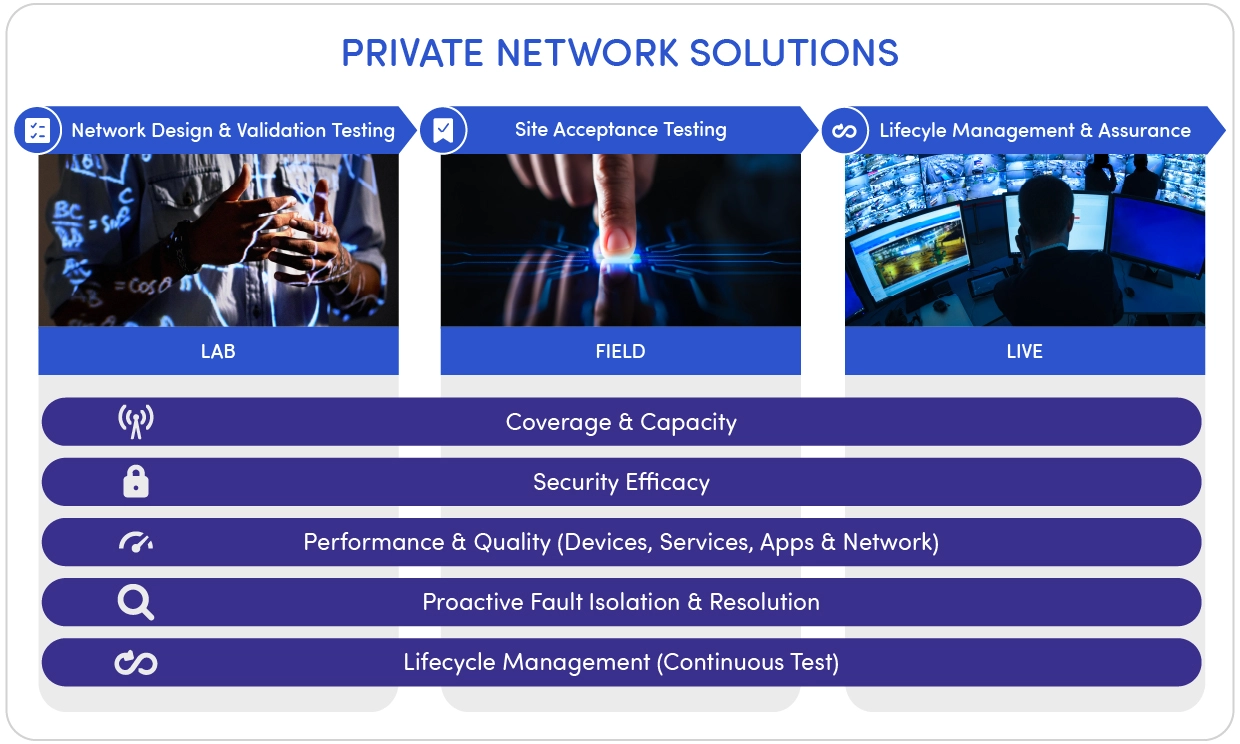Telecom is banking on 5G being an important driver of revenue-producing use cases for the enterprise market. The use cases take advantage of 5G’s expanded coverage, bandwidth for high-definition video, low latency, improved network integrity, security, and mobility handover, and network slices for mission critical applications and services.
But is progress toward realising this vision being made?
James Blackman, Global Editor-in-Chief at RCR Wireless, brought industry experts together to share perspective from real-world developments as part of the recent Private 5G In Industry 4.0 – Hype Vs. Reality, And Where The Market Goes From Here webinar. Panelists addressed the industry dynamics and status of private cellular networks, from testing, design and planning to installation and adoption.
A companion RCR Wireless News report delves into more detail on these topics.
Following are discussion highlights on testing goals and strategies as shared by Steve Douglas, Head of Market Strategy at Spirent.
Private Networks: Is the Industry 4.0 Era Upon Us?
While private networks are still in infancy, Spirent sees market momentum as a test and assurance company engaged end-to-end with customers, from R&D to commercial launches.
More than 1,200 5G/LTE private networks have been deployed in the last few years with many focused on improving efficiencies in the manufacturing sector. The largest growth has been in the transportation and logistics sector for initiatives like upgrading seaport connectivity, and the defense sector, typically incorporating private networks into military bases.
Most of the current demand is driven by network improvements, not fancy new use cases. Enterprises are using cellular networks to provide more reliable connectivity than is offered by existing networks and bridge complex network security environments. It helps that they are also willing to pay a premium for service-level agreements (SLAs) to ensure the availability and performance of mission-critical needs.
Deployments remain small, with only hundreds of connected devices, but these use cases are typically generating ROI in less than a year, building momentum for 5G private networks.
Plug-and-play solutions as easy entry points
This success comes as telecom focuses intently on lightweight, low-cost, plug-and-play, network-in-a-box offerings with multi-access edge computing (MEC). Such simplified entry points enable enterprises to achieve rapid ROI and gradually scale out as business cases evolve.
Private networks are set to play an important role in Industry 4.0 by enabling automation and digitization. Eventually, private networks will accelerate efficiency and productivity as they support networks of smart machines.
While we’re at the beginning of the journey to Industry 4.0, progress is being made on several fronts.
Private 5G test and assurance and lifecycle management in action
A key concern for many enterprises, especially mission critical enterprises, is ensuring the private network delivers the quality and performance required by the business. To that end, Spirent sees a need for holistic testing from network design and validation testing in the lab to network field acceptance testing to live monitoring and assurance of the private environment across the lifecycle.


Private 5G Network Testing from Lab to Live
Three examples of how Spirent private network customers and primes are benefiting from testing across the lifecycle, include private 5G:
-
Site field acceptance testing for a large enterprise. A key challenge for radio infrastructure deployment is whether it will deliver the appropriate performance on the relative spectrum bands for the bespoke requirements. Field testing results are also used to optimize the configuration with added small cells or radios, and to determine optimal locations.
-
Proactive assurance with a Tier 1 service provider. Active assurance guarantees the live operational private network delivers and meets its KPIs. The network is monitored and tested from outside as an end device or client to understand the perceived quality and experience the actual end application or service is receiving. This is critical for SLA management.
-
Lifecycle management with Telefónica. Automation is built into the private network offering to efficiently test and manage software upgrades and new releases as the network evolves from R16 to the R18 standards. As a result, upgrades are seamlessly deployed in the live environment, without downtime or large investments in retesting or revalidation.
Private networks: a catalyst for Industry 4.0
Panelists joining Spirent in the RCR Wireless webinar delivered insight on private cellular networks across the lifecycle, from testing, design and planning to integration with legacy networks.
Leo Gergs from ABI Research assessed the market dynamics as private 5G evolves from exploration to real commercial deployments. iBwave’s Nazim Choudhury discussed the requirements for modeling, designing, and deploying wireless networks and the value of digital twins to enable a data advantage. Peter Cappiello from Future Technologies covered how to incorporate 5G into legacy networks and provided case studies from multiple industry verticals.
Our conclusion was that private 5G networks at this stage of digital evolution are best started as small, realistic projects that can scale or expand over time. There are already plenty of individual use cases that don’t require huge network investments. They may be small, tailored use cases, but they solve real problems and have quickly demonstrated significant ROIs. That is a huge win for enterprises.
In 2024 and beyond, watch for continued productivity gains, guaranteed SLAs, and more automation which, combined with AI, will enable private networks to scale to the next generation of efficiency: Industry 4.0.
View the RCR Wireless webinar, Private 5G In Industry 4.0 – Hype Vs. Reality, And Where The Market Goes From Here, now for more details, download the companion RCR Wireless News Report, or read our solution brief for Advanced Validation for Private 5G Networks.
By Rich McNally




